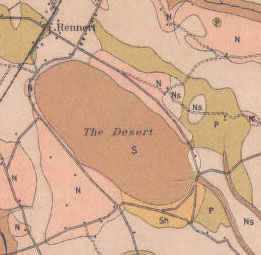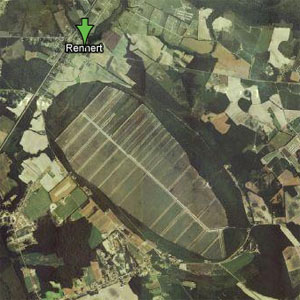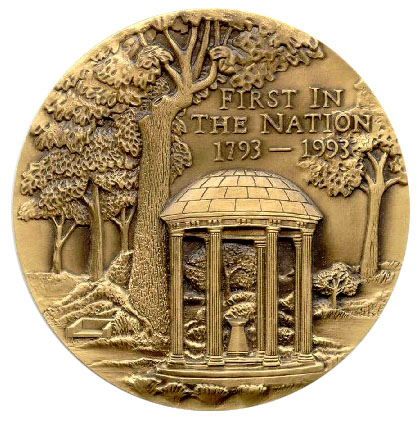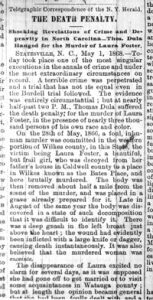In the past few weeks, two US Navy vessels bearing North Carolina-related names have been in the news. A new USS North Carolina, this one a fast-attack nuclear submarine, was christened in April 2007 and commissioned on May 3, 2008. It is the fourth Navy ship to bear the name “North Carolina,” with the previous one being the battleship now moored in Wilmington. In addition, a recent news story reports that the USS Kitty Hawk, the oldest active ship in the Navy, will be decommissioned.
Month: May 2008
Sir Archie: An Equine Superstar
The accompanying image depicts “Sir Archy” (Sir Archie being the preferred spelling), a champion racer generally recognized by sport historians as a “foundation sire of the American turf.” Foaled in Virginia in 1805, Sir Archie was purchased by William Ransom Johnson in 1808 and moved to Warrenton, N.C., for training. Sir Archie had several other Tar Heel owners. Former North Carolina Governor William R. Davie paid $5,000, an immense sum of money at the time, to add the stallion to his stables at Halifax in 1809. Later, William Amis, the owner of Mowfield Plantation in Northampton County, bought Sir Archie. It is there where the great horse died in 1833, having spent twenty-five of his twenty-eight years in North Carolina.
A prolific stud in retirement, Sir Archie sired many offspring and linked his bloodline to an array of later champions, including Lexington, Fair Play, Man O’War, Display, Native Dancer, and Secretariat. In addition, the current Triple Crown contender, Big Brown, is a descendent. The best reference for learning more about this legendary horse and about North Carolina’s early racing history is The Life and Times of Sir Archie written by Elizabeth Amis Cameron Blanchard and Manly Wade Wellman (Chapel Hill: UNC Press, 1958).
Life History Of Otto Wood
A recent comment on our blog mentioned the “Ballad of Otto Wood.” Well, we don’t have the sound clip up yet (though the Southern Folklife Collection does have several versions of the ballad in their collection), but the NC Collection does have the Life History of Otto Wood: Inmate, North Carolina State Prison, 1926.
Wood, who had been in and out of jails since he was seven years old and was infamous for his numerous (successful) escape attempts, wrote his life history while serving a thirty-year sentence for killing a man in a pawnshop robbery in 1923. He thought that the book would help “some fallen mortal to a higher life.” Well, it may have helped others to a higher life, but it sure didn’t help him. Over the next four years he escaped from Central Prison, was wounded and arrested again during an attempted burglary in Indiana, returned to Central Prison, escaped again, and was finally killed on December 31, 1930, in a shootout with police in Salisbury.
I can’t wait to hear the ballad.
Sound Comes to This Month in North Carolina
This Month in North Carolina for May, 2008, the story of Tom Dooley, is now wired for sound. This is a first for the NCC. The Southern Folklife Collection provided us with an audio file of G. B. Grayson and Henry Whittier performing a version of the Ballad of Tom Dooley from the 1920s. I like it a lot, but it is very different from the “Tom Dooley” made famous by the Kingston Trio in the 1950s. Read, listen, and enjoy!
Bicentennial of Andrew Johnson’s Birth
The year 2008 marks the 200th anniversary of the birth of Andrew Johnson, one of three U.S. presidents whom North Carolina claims as a native son. Born in Raleigh on December 29, 1808, Johnson was bound for several years as an apprentice to a local tailor. He left Raleigh while still a teenager and relocated to Greeneville, Tennessee, where he soon established his own clothing shop.
Many references pertaining to Johnson are preserved in the North Carolina Collection.

Our earliest book about him is the scarce 1865 edition Speeches of Andrew Johnson. Compiled by New York journalist Frank Moore and released in the months after Lincoln’s assassination, this volume contains a selection of Johnson’s speeches spanning the period between August 1848 and the end of April 1865. The book’s introductory section also provides a forty-eight-page biography on the seventeenth president.
The Big Desert
I thought I knew something about North Carolina history and geography, and felt pretty confident that I’d already spotted many of the oddities and mysteries lurking in old maps, but then somebody pointed out the Big Desert in Robeson County. It shows up on Samuel Pearce’s 1872 map of the state:

I know that sandy soil is common in eastern North Carolina, but the existence of an actual desert was news to me. I decided to look at later maps, to see if this was just a mistake or misunderstanding on the Pearce map, but sure enough, the desert showed up on one after the other. It was there on a 1884 map of the county, and then again on a 1908 soil survey, labeled simply as “The Desert”:

Soil survey maps are usually very reliable, so I decided to look at a recent satellite image to see if I could find anything roughly that shape near the town of Rennert. Here’s what I turned up using Google Maps:

The shape of that area looks exactly the same as that shown on the 1908 map. But the question remains, what in the world is it? Are there, among the many readers of this blog, any Robeson County residents who can tell us what exactly somebody would find if they went to the “Big Desert” today?
Hilfe!
Part of my job with the North Carolina Postcards project is to describe the postcards, including the messages written on them. Today I came across this Durham postcard, and you’ll notice that the message is written in German. Suffering a severe unfamiliarity with the language, I am having trouble transcribing it, and am wondering if any of you folks out there can help!
While a translation would be quite interesting, what we need most is an actual transcription of the message in German.
Any help?
“On, on went the dance till morning dawned”

A closer look at the 1885 UNC dance mentioned in a previous blog post has revealed the event’s importance in the history of dances on campus. According to Battle’s History of the University of North Carolina, it was customary for students to temporarily convert the library, then located in Smith Hall (present-day Playmakers Theater) for ballroom events. In 1884, however, University Trustees voted to ban all future dances in Smith Hall, responding to groups who felt that “modern dance” was “injurious to morals.” This put student planners of the 1885 Commencement Ball in quite a predicament, as Smith Hall was the only building on campus large enough to accommodate such events.
President Battle, who was more concerned over the use of the library as a dance hall than any threat to student morality, organized a corporation to erect a new building for that year’s Commencement Ball. Technically off-campus, but still in Chapel Hill, the building would serve as a much-needed gymnasium and a ballroom. Pictured above, the Old Gymnasium was eventually torn down in 1916, and would have been located between current Phillips and Peabody Halls.
The 1885 Commencement Ball became the first ball held off of University grounds and was a resounding success; students celebrated their graduation, and Battle and those opposed to dancing on campus got what they wanted. The following is a description of the festivities by an unnamed reporter: “The new, large and commodious Gymnasium Hall was a scene of gaiety and beauty … On, on went the dance till morning dawned, and then the merry throng began to break up to retire to sweet slumbers or to make ready to begin their journeys homeward.”
UNC Medallion Orbits the Earth
Among the large body of historic material preserved in the North Carolina Collection are thousands of coins and specimens of old paper money, along with hundreds of tokens, medals, and medallions.

This high-relief bronze medallion was produced in 1993 during celebrations marking the 200th anniversary of the laying of the cornerstone for “Old East,” the first building constructed at the University of North Carolina at Chapel Hill. The medallion’s obverse is decorated with two campus landmarks: the Old Well and the Davie Poplar, which is positioned to the left in the background. Both the well and this tree have been popular gathering spots for students and many important events in the school’s history. The old poplar, now heavily patched with cement and supported by wire cables, continues to bloom and shade a portion of McCorkle Place. Standing not far from it is “Davie Poplar, Jr.,” a tree planted in 1918 by students, who grafted a shoot from the senior tree onto a poplar sapling. Concerns for the Davie Poplar’s health prompted that planting. Lightning had seriously damaged the tree in 1873, and a windstorm in 1902 had inflicted additional injuries.
This thick, three-inch-wide medallion is exactly like another one preserved in the North Carolina Collection. That piece traveled over 4,500,000 miles aboard the Space Shuttle Discovery in September 1994. Dr. Jerry Linenger, a UNC alumnus and Discovery crew member, took the medallion with him on the ten-day orbital mission (STS-64). In compliance with NASA policy regarding astronauts taking personal belongings aboard the shuttle, the university keepsake had to be vacuum-sealed in plastic to prevent any possible contamination to the space vehicle. The medallion remains preserved today in NASA’s original protective packaging.
May 1868: The Death of Tom Dooley
This Month in North Carolina History
On the first of May, 1868, Thomas C. Dula met his death by hanging in Statesville, North Carolina, convicted of the murder of Laura Foster in the community of Elkville in Wilkes County on May 25, 1866. Dula’s execution ended a prolonged legal battle that included two trials and two appeals to the state supreme court and began the building of a legend in which fact and fiction mixed to create a story of love, jealously, betrayal, and murder. In the 1950s the Ballad of Tom Dooley, a musical version of the legend, was a hit song for the Kingston Trio.(Dooley was thought to be the local pronunciation of the name Dula.)
Listen to a 1920s version of the ballad by Grayson and Whittier.
 Stripped of the melodrama which came to surround them, the more or less agreed upon facts of the case are that on the 25th of May, 1866, twenty two year old Laura Foster left her father’s house on horseback, telling a friend whom she saw on the road that she was riding to meet Tom Dula who was going to marry her. Tom was seen by several people later that day going in the direction Laura had traveled. A day later Laura’s horse returned without her, and she was never seen alive again. Several unsuccessful searches were made for Laura during the summer. Tom was suspected of being involved in her disappearance, and some time late in June he fled the county, eventually going to work on the farm of James W. M. Grayson near Trade, Tennessee. Although no body had been found, a warrant was issued for Tom Dula’s arrest. He was captured in Tennessee by deputy sheriffs from Wilkes County with the aid of James Grayson and was jailed at Wilkesboro on July 11.
Stripped of the melodrama which came to surround them, the more or less agreed upon facts of the case are that on the 25th of May, 1866, twenty two year old Laura Foster left her father’s house on horseback, telling a friend whom she saw on the road that she was riding to meet Tom Dula who was going to marry her. Tom was seen by several people later that day going in the direction Laura had traveled. A day later Laura’s horse returned without her, and she was never seen alive again. Several unsuccessful searches were made for Laura during the summer. Tom was suspected of being involved in her disappearance, and some time late in June he fled the county, eventually going to work on the farm of James W. M. Grayson near Trade, Tennessee. Although no body had been found, a warrant was issued for Tom Dula’s arrest. He was captured in Tennessee by deputy sheriffs from Wilkes County with the aid of James Grayson and was jailed at Wilkesboro on July 11.
Early in August 1866, Ann Melton, a married woman of the Elkville community, told Pauline Foster (no relation to Laura) that she knew the location of Laura Foster’s grave. Under suspicion herself of complicity in Laura’s disappearance, Pauline passed this story on to the authorities, who located the shallow grave containing Laura’s corpse early in September. Tom Dula and Ann Melton were indicted for the murder of Laura Foster on October 1, 1866.
The subsequent trial revealed a web of sexual relationships and violence that both disgusted and fascinated observers at the time. Tom Dula was known as a womanizer, having formed a sexual liaison with Ann Melton—perhaps with her husband’s knowledge—in about his fifteenth year, which lasted until he enlisted in the 42nd North Carolina Regiment of infantry in 1862. Tom returned from the war in June 1865 and took up again with Ann, while at the same time beginning sexual affairs with Pauline Foster, who worked for the Meltons, Laura Foster, and at least one other woman. Some time in March, 1866, Tom became aware that he had a venereal disease, probably syphilis, which had also infected Ann Melton, her husband, and Pauline Foster. Although Pauline seems to have been the source of the infection, Tom believed he had caught it from Laura Foster and threatened her publicly.
Tom Dula was represented at his trial by Zebulon Baird Vance, former governor of North Carolina and future United States senator, one of the best lawyers in the state. Vance obtained a change of venue for the trial to Statesville in Iredell County and got Tom’s trial separated from Ann Melton’s. The state called several witnesses, but relied primarily on circumstantial evidence linking Tom to the vicinity of Laura’s grave and the testimony of Pauline Foster. The jury brought in a guilty verdict on October 21, 1866, but Vance appealed to the Supreme Court of North Carolina, which ordered a new trial. After some delay, the second trial began on January 20, 1868, and once again Tom was convicted. This time the North Carolina Supreme Court upheld the conviction, and Tom Dula was hanged. Just before his death Tom wrote a short note saying that Ann Melton had had no part in Laura Foster’s death. Primarily on the strength of this note, Ann was acquitted.
Over the years story tellers and writers transformed the murder into a tragic love triangle about an innocent young girl, Laura Foster; a wicked, jealous woman, Ann Melton; and caught between them, Tom Dula, a victim of circumstances. Some characters in these stories are changed beyond recognition. James W. M. Grayson, on whose farm Tom worked after he fled Wilkes County, and who aided in his arrest, becomes Tom’s nemesis. In some accounts he is the vengeful sheriff of Wilkes, chasing Tom into Tennessee. In some, he is Tom’s rival for the affection of Laura Foster, bitter with jealousy. The story was also remembered in song, according to legend first sung by Dula himself. Folklorist Frank Warner heard Frank Proffitt of Watauga County, North Carolina, sing a version of the Ballad of Tom Dooley which came ultimately from his grandmother, who knew both Tom Dula and Laura Foster. It was this version that the Kingston Trio recorded in 1958.
Sources
John Foster West. The Ballad of Tom Dula: The Documented Story Behind the Murder of Laura Foster and the Trials and Execution of Tom Dula. Boone, NC: Parkway Publishers, Inc., 2002.
Rufus L. Gardner. Tom Dooley: The Eternal Triangle. Mount Airy, NC: The Author, c1960.
Image Source:
Wilmington Journal, May 8, 1868. North Carolina Collection, Wilson Library, University of North Carolina at Chapel Hill.
Audio Source:
“Tom Dooley.” Going Down Lee Highway: 1927-1929 recordings. Davis Unlimited Records, 1977. Southern Folklife Collection, Wilson Library, University of North Carolina at Chapel Hill.



